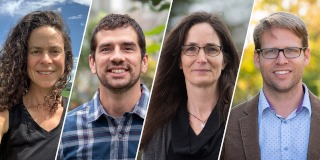By Rachel Leslie
Over the past decade, Vermont dairy farmers have taken steps to become more sustainable through on-farm practices like cover cropping, conservation tillage and other soil health management strategies. Now, a team of University of Vermont researchers has joined a nationwide effort to quantify the impact of these practices and evaluate the potential for the U.S. dairy industry to reach net zero environmental goals by 2050.
The goals, set by the Innovation Center for U.S. Dairy, include becoming carbon neutral or better, optimizing water use, and improving water quality. The targets are part of the Net Zero Initiative, a collaboration of U.S. dairy organizations, scientists and researchers working to help farms adopt sustainable practices in feed production, cow care and manure management, identify new market opportunities and address research gaps.
“We’re looking for a win-win for how farms can be part of the climate change solution and maintain financial viability,” said Joshua Faulkner, of UVM’s Department of Plant and Soil Science and UVM Extension. “We think that healthy soils can potentially play a role in carbon sequestration and water quality, but there are a lot of unknowns in terms of the optimal soil management strategies for different farming systems with different climates and soils.”
In Vermont, Faulkner is leading an interdisciplinary team of researchers to measure the impact of an optimal soil health management program at Audet’s Blue Spruce Farm in Bridport. The work is part of a six-year, multi-institutional project funded with $23 million from the Foundation for Food & Agriculture Research (FFAR), corporate partners and in-kind support to evaluate changes in greenhouse gas emissions, soil carbon storage, soil health and water quality at dozens of farms across the major dairy producing regions of the country. The UVM work will be supported by a $850,000 grant from FFAR.

UVM Research Team: Kirsten Workman, Joshua Faulkner, Carol Adair and Eric Roy
“What’s exciting is that we are testing the potential for regenerative agriculture to improve soil health in a variety of contexts across the country,” said Eric Roy of the UVM’s Department of Civil and Environmental Engineering and the Rubenstein School for Environment and Natural Resources, who will lead the soil data collection and analysis on the project. “For example, differences in soil type, environmental factors and prior land management across the nation likely affect the potential for practices to boost soil health and carbon storage. Better understanding of these relationships can guide evidence-based soil management moving forward.”
The greater opportunity for improvement in Vermont, says Faulkner, is soil health management strategies to reduce phosphorus pollution from farm run-off and improve water quality in the Lake Champlain Basin. While phosphorus — found in fertilizer, animal feed and manure — is essential for crop growth, it’s a problem at high levels, causing pollution and toxic algae blooms. Agriculture plays a substantial role in the state’s phosphorus problem and climate change is increasing pressure on farms to adopt soil health practices to reduce their phosphorus runoff while adapting to changing weather patterns.
“Water is moving through the landscape faster and in more ways than it used to. With more heavy storms and intense rainfall, we’re seeing a lot more erosion and nutrient runoff,” said Faulkner. “Our farmers have really done a lot in the past five to 10 years, but there is still a lot of work to be done.”
Recognizing the need to adapt, Blue Spruce Farm invested heavily in sustainability. One of the largest dairies in Vermont, the farm manages a herd of over 1,500 cows and 4,000 acres of cropland for feed. Blue Spruce uses practices like cover cropping and conservation tillage to help reduce erosion and nutrient runoff and operates an anerobic digester that converts cow manure into renewable energy.
Learn more about Blue Spruce Farm's no till planting methods in the below segment from Across the Fence.
“We farmers have long prided ourselves on being the very best stewards of our lands,” said Marie Audet of Blue Spruce Farm. “The signs of our changing climate are clear, and like every other industry, we have to evolve. We want to know what the return on our investments are, what conservation efforts are yielding the best results, and how we can do better.”
Faulkner, Roy, Carol Adair, also from the Rubenstein School, and Kirsten Workman, an agronomy specialist with UVM Extension, will work with Audet to evaluate the impacts of an advanced soil health management strategy compared to “business as usual” practices on two adjacent farm fields over six years. The research will evaluate water quality outcomes at the farm and the watershed level, greenhouse gas emissions and soil health outcomes and inform work at the national level comparing management strategies in different farming regions.
“Everything our farmers have been doing to support healthy soils is moving in the right direction for agriculture to help mitigate some of the effects of climate change,” said Faulkner. “With this project, I really hope we can identify optimum management scenarios for farms and ensure they remain viable in the long-term.”
Source : uvm.edu